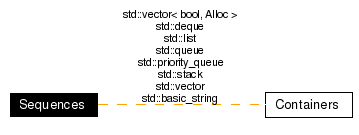
|
Collaboration diagram for Sequences:

|
Classes | |
| class | std::vector< bool, Alloc > |
| A specialization of vector for booleans which offers fixed time access to individual elements in any order. More... | |
| class | std::deque< Type, Alloc > |
| A standard container using fixed-size memory allocation and constant-time manipulation of elements at either end. More... | |
| class | std::list< Type, Alloc > |
| A standard container with linear time access to elements, and fixed time insertion/deletion at any point in the sequence. More... | |
| class | std::queue< Type, Sequence > |
| A standard container giving FIFO behavior. More... | |
| class | std::priority_queue< Type, Sequence, Compare > |
| A standard container automatically sorting its contents. More... | |
| class | std::stack< Type, Sequence > |
| A standard container giving FILO behavior. More... | |
| class | std::vector< Type, Alloc > |
| A standard container which offers fixed time access to individual elements in any order. More... | |
| class | std::basic_string< CharT, Traits, Alloc > |
| Managing sequences of characters and character-like objects. More... | |
The differences between sequences are usually due to one or both of the following:
As an example of the first case, vector is required to use a contiguous memory layout, while other sequences such as deque are not.
The prime reason for choosing one sequence over another should be based on the second category of differences, algorithmic complexity. For example, if you need to perform many inserts and removals from the middle of a sequence, list would be ideal. But if you need to perform constant-time access to random elements of the sequence, then list should not be used.
All sequences must meet certain requirements, summarized in tables.
 1.4.2
1.4.2